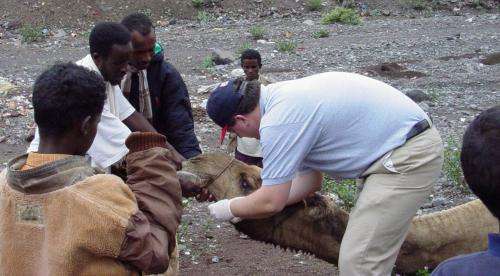Researcher studies impact of disease and climate change on camel herd in Africa

An Iowa State University veterinary researcher is helping to protect camel herds in East Africa from the ravages of climate change and disease, a project that will strengthen food security and human health for people throughout the region.
Paul Plummer, an assistant professor of veterinary diagnostic and production animal medicine, leads the Camel Adaptation and Medicine in the East-African Landscape Project. The project seeks to build the capacity of veterinary labs in Ethiopia and nearby countries to work on diseases that threaten camels, a major livestock option for much of the region's population.
Funded by the USAID Feed the Future Innovation Laboratory for Adapting Livestock to Climate Change located at Colorado State University, the first phase of the initiative started in April 2014 and will conclude later this year. ISU researchers, with the help of the Ethiopian Ministry of Agriculture's National Animal Health Diagnostic and Investigation Center and a non-governmental organization with personnel based in East Africa, are gathering data on the diseases and challenges faced by local camel herds.
The veterinary infrastructure in Ethiopia and neighboring countries is limited in its capacity to diagnose camels. That has serious repercussions for populations that depend on camels for their health and livelihoods.
"Some of the populations we're talking about are some of the most food insecure in the world," Plummer said. "For children, especially, almost all of their protein comes from camel meat and milk."
Plummer said about 15 million of the 19 million camels in the world are located in the East African countries of Ethiopia, Somalia, Djibouti, Eritrea and Sudan. The arid climate of the region limits options for raising livestock, but camels, which can go up to a week without water, have the advantage of being one of the most drought-resilient species.
But drought has grown as a concern in recent years, leading to a shrinkage of grazing land, and the weather extremes can give rise to malnutrition and other health concerns for camel herds, he said. The region's climate, which alternates between wet and severely dry seasons, has a large impact on diseases that target camels, he said. But even the wet season, which usually sees fewer than six inches of rainfall, stays fairly arid.
The project team has tested more than 3,000 samples taken from camels in the region. The goal is to build a database of diseases, parasites and health concerns most common to the herd. At the same time, personnel are conducting interviews with local camel herders to get a sense of their top priorities for protecting their camels.
"The goal is to assess what the biggest threats are and use the data in a future phase of the project to improve the availability of viable treatments for those diseases," Plummer said.
Because of limitations in local infrastructure, most of the tests and treatments the project will develop and recommend can't rely on electricity or refrigeration for delivery and effectiveness, he said.
Provided by Iowa State University

















